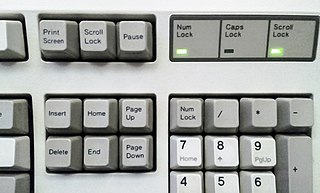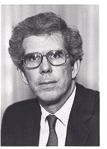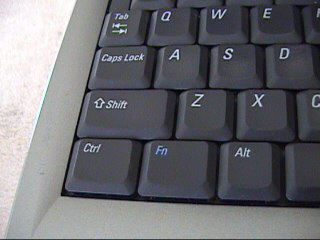Related Research Articles

In computing, BIOS is firmware used to provide runtime services for operating systems and programs and to perform hardware initialization during the booting process. The firmware comes pre-installed on the computer's motherboard.
The keyboard for IBM PC-compatible computers is standardized. However, during the more than 30 years of PC architecture being frequently updated, many keyboard layout variations have been developed.

Scroll Lock is a lock key on most IBM-compatible computer keyboards. Depending on the operating system, it may be used for different purposes, and applications may assign functions to the key or change their behavior depending on its toggling state. The key is not frequently used, and therefore some reduced or specialized keyboards lack Scroll Lock altogether.
System Request is a key on personal computer keyboards that has no standard use. Introduced by IBM with the PC/AT, it was intended to be available as a special key to directly invoke low-level operating system functions with no possibility of conflicting with any existing software. A special BIOS routine – software interrupt 0x15, subfunction 0x85 – was added to signal the OS when SysRq was pushed or released. Unlike most keys, when it is pressed nothing is stored in the keyboard buffer.

In computing, a Control keyCtrl is a modifier key which, when pressed in conjunction with another key, performs a special operation. Similarly to the Shift key, the Control key rarely performs any function when pressed by itself. The Control key is located on or near the bottom left side of most keyboards, with many featuring an additional one at the bottom right.

A function key is a key on a computer or terminal keyboard that can be programmed to cause the operating system or an application program to perform certain actions, a form of soft key. On some keyboards/computers, function keys may have default actions, accessible on power-on.

The Alt keyAlt on a computer keyboard is used to change (alternate) the function of other pressed keys. Thus, the Alt key is a modifier key, used in a similar fashion to the Shift key. For example, simply pressing A will type the letter 'a', but holding down the Alt key while pressing A will cause the computer to perform an Alt+A function, which varies from program to program. The international standard ISO/IEC 9995-2 calls it Alternate key. The key is located on either side of the space bar, but in non-US PC keyboard layouts, rather than a second Alt key, there is an 'Alt Gr' key to the right of the space bar. Both placements are in accordance with ISO/IEC 9995-2. With some keyboard mappings, the right Alt key can be reconfigured to function as an AltGr key although not engraved as such.

Philip Donald Estridge, known as Don Estridge, was an American computer engineer who led development of the original IBM Personal Computer (PC), and thus is known as the "father of the IBM PC". He opened its specifications, which revolutionized the computer industry, resulting in a vast increase in sales of personal computers and creating an entire industry of hardware compatible PCs.
Common User Access (CUA) is a standard for user interfaces to operating systems and computer programs. It was developed by IBM and first published in 1987 as part of their Systems Application Architecture. Used originally in the MVS/ESA, VM/CMS, OS/400, OS/2 and Microsoft Windows operating systems, parts of the CUA standard are now implemented in programs for other operating systems, including variants of Unix. It is also used by Java AWT and Swing.
BIOS implementations provide interrupts that can be invoked by operating systems and application programs to use the facilities of the firmware on IBM PC compatible computers. Traditionally, BIOS calls are mainly used by DOS programs and some other software such as boot loaders. BIOS runs in the real address mode of the x86 CPU, so programs that call BIOS either must also run in real mode or must switch from protected mode to real mode before calling BIOS and then switching back again. For this reason, modern operating systems that use the CPU in Protected mode or Long mode generally do not use the BIOS interrupt calls to support system functions, although they use the BIOS interrupt calls to probe and initialize hardware during booting. Real mode has the 1MB memory limitation, modern boot loaders use the unreal mode or protected mode to access up to 4GB memory.

The IBM RT PC is a family of workstation computers from IBM introduced in 1986. These were the first commercial computers from IBM that were based on a reduced instruction set computer (RISC) architecture. The RT PC uses IBM's proprietary ROMP microprocessor, which commercialized technologies pioneered by IBM Research's 801 experimental minicomputer. The RT PC runs three operating systems: AIX, the Academic Operating System (AOS), and Pick.

The Option key, ⌥, is a modifier key present on Apple keyboards. It is located between the Control key and the Command key on a typical Mac keyboard. There are two Option keys on modern Mac desktop and notebook keyboards, one on each side of the space bar.
The magic SysRq key is a key combination understood by the Linux kernel, which allows the user to perform various low-level commands regardless of the system's state. It is often used to recover from freezes, or to reboot a computer without corrupting the filesystem. Its effect is similar to the computer's hardware reset button but with many more options and much more control.

The Fn key, short form for function, is a modifier key on many keyboards, especially external keyboards, and is not available for mobile devices. For use in a compact layout, combine keys which are normally kept separate. It-Alt + FN is typically found on laptops due to their keyboard size restrictions. It is also found on many full-sized "multimedia" keyboards as the F-Lock key. It is mainly for the purpose of changing display or audio settings quickly, such as brightness, contrast, or volume, and is held down in conjunction with the Caps Lock to change the settings.
On personal computers with numeric keypads that use Microsoft operating systems, such as Windows, many characters that do not have a dedicated key combination on the keyboard may nevertheless be entered using the Alt code. This is done by pressing and holding the Alt key, then typing a number on the keyboard's numeric keypad that identifies the character and then releasing Alt.
In a computer or data transmission system, a reset clears any pending errors or events and brings a system to normal condition or an initial state, usually in a controlled manner. It is usually done in response to an error condition when it is impossible or undesirable for a processing activity to proceed and all error recovery mechanisms fail. A computer storage program would normally perform a "reset" if a command times out and error recovery schemes like retry or abort also fail.
Jack D. Kuehler was an American electrical engineer who devoted the majority of his career at IBM, where he was the firm's highest ranking technologist, serving as president and later vice chairman of the company.
In computing, rebooting is the process by which a running computer system is restarted, either intentionally or unintentionally. Reboots can be either a cold reboot in which the power to the system is physically turned off and back on again ; or a warm reboot in which the system restarts while still powered up. The term restart is used to refer to a reboot when the operating system closes all programs and finalizes all pending input and output operations before initiating a soft reboot.
Control-Alt-Delete is a computer keyboard command on IBM PC compatible computers, invoked by pressing the Delete key while holding the Control and Alt keys: Ctrl+Alt+Delete. The function of the key combination differs depending on the context but it generally interrupts or facilitates interrupting a function. For instance, in pre-boot environment or in MS-DOS, Windows 3.0 and earlier versions of Windows or OS/2, the key combination reboots the computer. Starting with Windows 95, the key combination invokes a task manager or security related component that facilitates ending a Windows session or killing a frozen application.
William Cleland Lowe was an IBM Executive and is known as the "Father of the IBM PC".
References
- ↑ Aamidor, Abe (2003). "Thank this guy for 'control-alt-delete'". Indianapolis Star . Archived from the original on 2017-09-10. Retrieved 2003-10-02.
- ↑ IBM Personal Computer Technical Reference (Revised ed.). IBM Corporation. March 1983.
- ↑ Control-Alt-Delete: David Bradley & Bill Gates, video clip from IBM PC 20th Anniversary, Aug 8, 2001 (posted to YouTube on Jan 7, 2011)
- ↑ Orlowski, Andrew (2004-01-29). "Ctrl-Alt-Del inventor makes final reboot - David Bradley, we salute you". The Register . Bootnotes. Archived from the original on 2012-10-03. Retrieved 2013-09-28.
- ↑ Archived at Ghostarchive and the Wayback Machine : "Exidy Sorcerer". YouTube . Retrieved 27 May 2016.
- ↑ Warren, Carl (June 1982). "Computer Bits, New Boards Work - and Play - Hard" (PDF). Popular Electronics. Retrieved 27 May 2016.
- ↑ Moyars-Johnson, Mary; Gelfand, Jo (1997). "1997 Outstanding Electrical Engineer Awards: Bradley, Held, Lindsey, Mayer, and Sears Named Outstanding Electrical Engineers". WaveLinks. School of Electrical and Computer Engineering, Purdue University . Retrieved 2013-09-28.